Bathroom Windows with Blinds Inside: A Comprehensive Guide
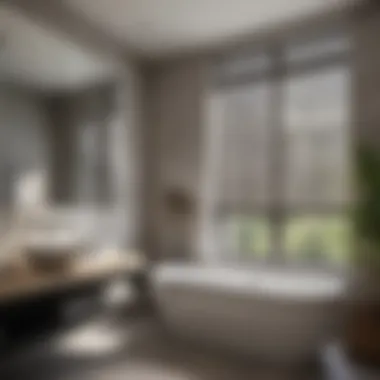
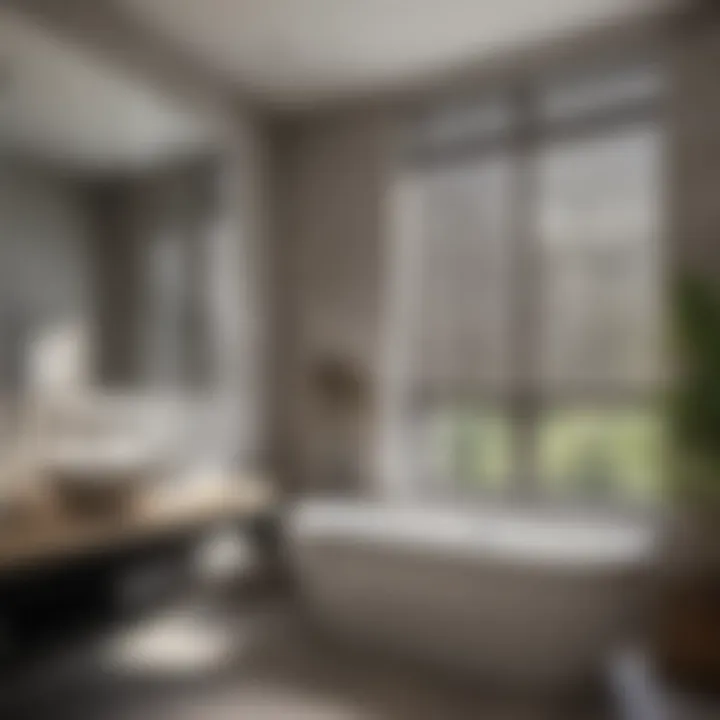
Materials:
When undertaking a project to install bathroom windows with blinds inside, choosing the right materials is essential. Here is a detailed list of what you will need:
- Window Frame: Select a vinyl or fiberglass frame. Typically, an average frame size of 24” x 36” is common for bathrooms.
- Blinds: Consider using mini-blinds that fit within the window pane. The typical width should match the window frame width, around 22” for the above size.
- Window Glass: Double glazing is advisable for better insulation. Choose energy-efficient glass that matches the frame.
- Sealant: Silicone sealant, typically 100% silicone, is needed for airtight sealing.
- Screws: Use exterior-grade screws, 1.5” in length, for secure installation.
- Trim Kit: For adding finishing touches; usually, 1” x 4” boards work well.
Additional Materials:
- Caulk: A tube of caulk for additional moisture protection.
- Weatherstripping: This can help improve insulation and prevent leaks. A 1/2 inch width is standard.
Tools:
Before starting the installation, gather the following tools:
- Measuring Tape: To ensure accurate measurements.
- Level: To check proper alignment of the window.
- Drill: A power drill for making pilot holes and driving screws.
- Screwdriver: For tightening screws securely.
- Utility Knife: For cutting insulation and other materials.
- Safety Glasses: Always wear protective eyewear during the installation process.
DIY Steps:
- Preparation:
- Cutting and Fitting:
- Install Window Frame:
- Inserting Blinds:
- Sealing:
- Trimming:
- Measure the window opening carefully to ensure a good fit. Mark all measurements clearly.
- If needed, adjust your window frame to fit. Cut the frame materials to size using a saw.
- Position the frame in the opening. Use the level to confirm it is straight.
- Attach with screws, making sure it is snug.
- Position the mini-blinds according to the manufacturer's instructions. Ensure they operate freely without obstruction.
- Apply silicone sealant around the edges of the frame. This prevents water damage and air leaks.
- Attach the trim to cover gaps and add aesthetic appeal. Use caulk to seal any visible seams.
Technical Aspects:
Understanding certain technical elements can greatly enhance your project:
- Timing: The installation process usually takes about 3 to 5 hours, depending on skill level and conditions.
- Techniques for Quality: Always double-check measurements before cutting. Using a second pair of hands can help manage the window safely during installation.
Troubleshooting Tips:
- Uneven Frame: If you notice the frame is not level, loosen the screws and adjust the position. Retighten once aligned.
- Blinds Not Operating: Ensure that blinds are not obstructed by frame materials and check the mechanism for jams.
- Water Leakage: Inspect sealant application; if necessary, remove old sealant and reapply adhering to manufacturer guidelines.
Remember: A well-installed bathroom window with blinds inside not only enhances aesthetic value but also provides practical solutions to light control and privacy needs.
Foreword to Bathroom Windows with Blinds Inside
The inclusion of blinds within bathroom windows represents a significant advancement in both functionality and aesthetics. This design trend not only provides practical benefits but also enhances the overall feel of the space. Choosing the right window option with internal blinds can dramatically alter how light and privacy are controlled in a bathroom.
Definition and Concept
Bathroom windows with built-in blinds integrate privacy solutions with window functionality. The blinds are housed within a sealed space between two panes of glass. This design keeps them dust-free and minimizes the need for manual manipulation. Individuals enjoy maximum privacy without sacrificing the abundant natural light that windows provide.
Enhancing privacy is crucial, especially in bathroom spaces. Homeowners often face challenges with traditional blinds, including dust accumulation and difficult cleaning. Integrating blinds inside the window eliminates these problems. It offers a sleek, modern look that aligns with contemporary bathroom designs.
History and Evolution
The concept of internal blinds began gaining traction in the last few decades. Initially, window treatment options were crowded with various external designs, but customers wanted a more minimalist approach. This evolution towards internal solutions echoed broader trends in home design focusing on clean lines and functionality.
Historically, bathrooms tend to have utilitarian aesthetics. The introduction of internal blinds allowed for better design possibilities, making way for a more inviting environment. As preferences shifted toward integrated solutions, manufacturers responded with innovative products that include various materials and styles to suit diverse tastes.
This evolution underscores a movement in home design where functionality meets aesthetic appeal, a critical factor for many homeowners aiming to create serene bathroom spaces. Such transformations reflect the audience's demand for spaces that accommodate modern living needs without compromising on style and comfort.
Advantages of Internal Blinds in Bathroom Windows
In the search for the perfect balance between aesthetics and functionality, bathroom windows with internal blinds offer unique advantages. The integration of blinds not only enhances the beauty of the space but also adds practical benefits that suit the specific needs of a bathroom. This section outlines several key advantages, highlighting the considerations important for homeowners and designers alike.

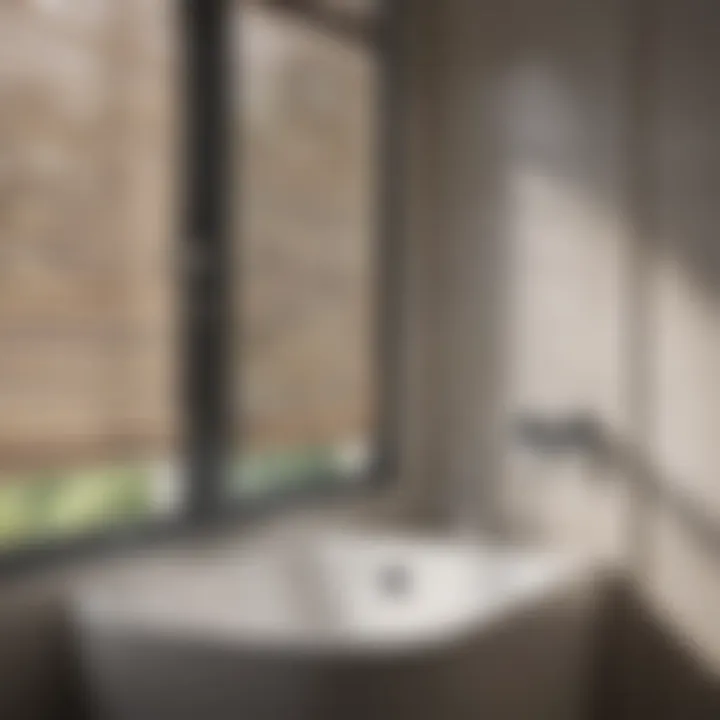
Enhanced Privacy Control
One of the most significant advantages of internal blinds is the level of privacy they provide. Bathrooms are intimate spaces, often needing a barrier from the outside world. Internal blinds allow users to easily adjust the level of visibility from within or outside the bathroom. This flexibility means that homeowners can close the blinds completely when privacy is needed, or open them up to let light in when desired.
Moreover, the installation of blinds within the glass eliminates the need for standard window treatments that can be bulkier or obstructive. This seamless design not only keeps the bathroom looking clean and tidy but also emphasizes personal comfort. The ability to regulate sightlines can profoundly influence the overall bathroom experience, making it an essential feature for many.
Improved Light Management
Light is a critical factor in any bathroom, influencing both functionality and ambiance. Internal blinds facilitate effective light management. By adjusting the blinds, users can control how much natural light enters the space. This capability is particularly beneficial for tasks such as skincare or applying makeup, where optimal lighting is crucial.
Furthermore, internal blinds can minimize glare, providing a more comfortable environment. Unlike traditional curtains or shades, which may collect dust and may not block out light effectively, built-in blinds reside within the window glass, reducing the hassle of frequent cleaning. This design ensures a better distribution of light throughout the day, enhancing the feel of the room.
Reduced Dust and Allergens
Homeowners often underestimate the presence of dust and allergens in their living spaces, especially in areas like bathrooms where moisture levels can be higher. Internal blinds can significantly reduce the accumulation of dust, as they do not have the same exposed fabric that curtains do.
When compared to conventional window treatments, internal blinds remain cleaner and require less maintenance. This aspect is particularly relevant for individuals who suffer from allergies, as a cleaner environment promotes better air quality. By minimizing allergens, homeowners contribute to a healthier bathroom atmosphere, making it a sanctuary for relaxation and personal hygiene.
"The integration of internal blinds supports both aesthetics and functionality, impacting the overall bathroom experience positively."
These advantages make internal blinds a practical choice for bathroom windows. They offer more than just a means to cover a window; they bring a level of convenience and design that meets the modern homeowner’s expectations, aligning well with the desire for thoughtful and efficient home spaces.
Different Materials for Internal Blinds
Choosing the right material for internal blinds is essential for both functionality and aesthetics. The material you select can affect light control, insulation, maintenance, and overall style. Let's examine three of the most popular types of materials used for internal blinds: vinyl, wood, and aluminum. Each has its unique merits and considerations, helping home owners make informed decisions.
Vinyl
Vinyl is a widely adopted option for internal blinds, particularly in bathrooms. It offers several advantages that align well with the demands of a space exposed to moisture.
- Water Resistance: Vinyl blinds resist moisture, making them ideal for humid bathroom environments. They do not warp or deteriorate as wood might when exposed to high humidity.
- Easy Maintenance: Cleaning vinyl is straightforward. A damp cloth or sponge can easily wipe away dirt and stains. This is particularly helpful for busy households.
- Affordability: Compared to other materials, vinyl tends to be more cost-effective, allowing for budget-friendly renovations.
While vinyl blinds may lack the warmth and elegance of natural materials, they compensate with practicality. This makes vinyl a solid choice for home owners prioritizing functionality over style.
Wood
Wooden blinds bring a natural beauty to bathroom windows. Their aesthetic appeal is hard to deny, featuring rich textures and colors that can complement various design schemes.
- Elegant Appearance: Wooden blinds are visually appealing. They provide a sense of warmth that many home owners find attractive in their bathrooms.
- Versatility: Available in different finishes, wooden blinds can match any decor, from rustic to modern. This versatility is a big plus.
- Insulation: Wood naturally insulates better than metal, helping to regulate temperature and maintain privacy. This feature is essential for energy efficiency in homes.
However, wooden blinds do come with drawbacks. They are more susceptible to moisture damage, requiring careful makeup and treatment to withstand bathroom conditions. Home owners must weigh these considerations before opting for wood blinds.
Aluminum
Aluminum blinds represent another reliable choice for internal blinds, especially in modern bathrooms. They bring unique characteristics that can cater to specific preferences.
- Durability: Aluminum is highly durable and resistant to warping or bending. This material stands up well in bathrooms, ensuring longevity.
- Lightweight: Being lightweight makes installation easier. Home owners often find it less cumbersome to handle compared to wood or vinyl.
- Sleek Look: Aluminum offers a modern, minimalist appearance. This can align well with contemporary interior designs, providing a clean-lined aesthetic.
Despite its strengths, aluminum blinds can conduct heat, which may not aid in energy efficiency during extreme weather. Therefore, while it is a practical choice, it's essential to consider how they will function within the specific environment of the bathroom.
The choice of material for internal blinds should reflect both practical needs and personal style. Assessing the pros and cons allows home owners to find the perfect fit for their bathrooms.
Styles of Bathroom Windows with Internal Blinds
The design of bathroom windows plays a crucial role in establishing both functionality and aesthetics. When considering styles of bathroom windows with internal blinds, it is essential to evaluate how these windows contribute to light control, privacy, and overall visual appeal. Each window style comes with unique advantages, ensuring that homeowners can select an option that meets their specific needs. In this section, we will explore three popular styles: Casement, Sliding, and Fixed windows.
Casement Windows
Casement windows are hinged on one side and open outward. This style is favored for its ease of use and extensive ventilation capabilities. The inclusion of internal blinds provides an elegant solution for managing light and privacy without obstructing the window’s functionality.
- Ventilation: Casement windows, when opened, allow fresh air to flow smoothly into the bathroom. Having internal blinds means ventilation can be enjoyed while maintaining privacy during the day.
- Design Flexibility: These windows can fit various design themes, from traditional to modern. The internal blinds assist in enhancing the window's aesthetics while providing a sleek appearance.
- Durability: With fewer moving parts exposed to external elements, internal blinds in casement windows can be less prone to wear and tear compared to traditional external blinds.
Sliding Windows
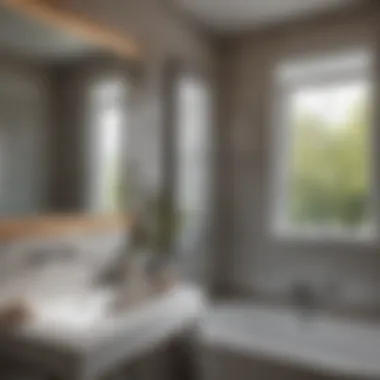
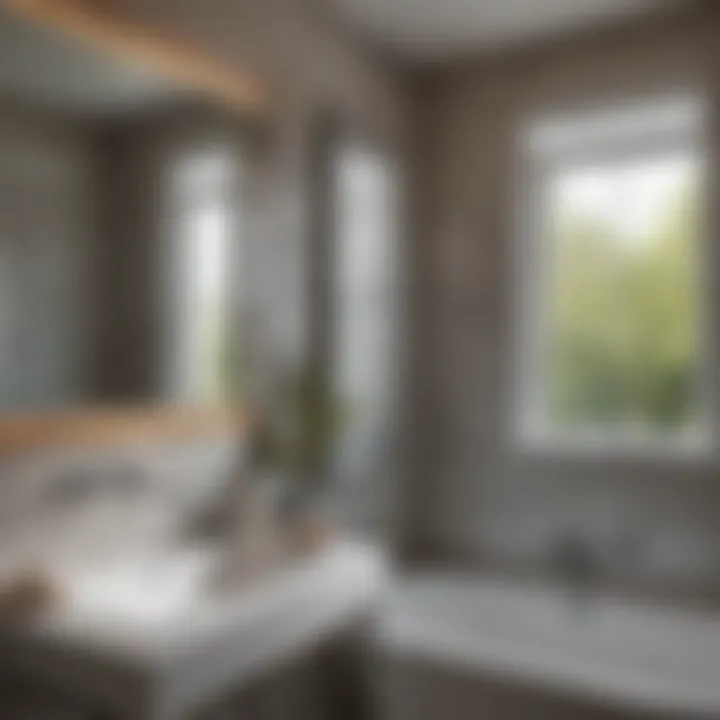
Sliding windows consist of two or more sashes that glide horizontally. This modern option is a popular choice for bathrooms due to its space-saving design. Internal blinds integrated in sliding windows offer a seamless look that complements contemporary styling.
- Space Efficiency: Unlike casement windows, sliding windows do not require additional space to open, making them ideal for compact bathrooms.
- Ease of Operation: These windows are easy to open and close, which can be particularly helpful when hands are wet or occupied.
- Light Control: With internal blinds, users can effortlessly adjust light levels throughout the day, providing an effective barrier against harsh sunlight while still maintaining a feeling of openness.
Fixed Windows
Fixed windows are stationary panes that do not open. Their primary function is to provide light and views without ventilation. Incorporating internal blinds in fixed windows allows for an optimal mix of illumination and privacy.
- Maximized Natural Light: Fixed windows can let in a substantial amount of natural light, making the bathroom feel more spacious. Internal blinds can modulate this light as needed.
- Simplicity in Design: These windows are often used in minimalist designs, where clean lines and unobtrusive elements are valued. The inner blinds contribute to this design without visible hardware clutter.
- Low Maintenance: Since they are not operable, fixed windows are generally easier to maintain. The internal blinds are also protected from dust and grime, making them more hygienic than traditional external blinds.
In summary, the style of bathroom windows with internal blinds influences functionality and aesthetics. Choosing between casement, sliding, or fixed windows should take into account the specific needs in terms of privacy, light control, and overall design integration.
Installation Considerations
When pondering the inclusion of bathroom windows with blinds inside, the installation considerations become a pivotal aspect of the entire process. Not only do these considerations affect the functionality and aesthetics of the windows, but they also play a significant role in ensuring that the installation meets all necessary standards and operates effectively for years to come. It’s essential to evaluate various elements like size, installation method, and compliance with regulations.
Choosing the Right Size
Selecting the correct size for bathroom windows is critical. If the window is too small, it may not provide adequate light or ventilation. Conversely, a window that is too large can overpower the room's proportions and lead to privacy concerns. Measurements must be taken meticulously.
- Measure the Space: Use a tape measure to determine the width and height of the installation space.
- Consider Placement: Windows should be placed strategically to allow for natural light while still affording privacy.
- Frame Material: Keep in mind how the frame material can impact the perceived size of the window. For instance, a slim frame can enhance the window's visual size, while a bulky frame may reduce the effect.
Professional vs. DIY Installation
When it comes to installation, homeowners often face the choice between hiring professionals or opting for a do-it-yourself approach. Both options carry advantages and challenges.
- Professional Installation: Hiring a contractor ensures expert work. Professionals have the experience and tools necessary for measuring, cutting, and securing windows properly. Additionally, they are familiar with local codes and regulations.
- DIY Installation: On the other hand, a DIY installation may save money. This route can provide a sense of accomplishment, but it requires careful planning and execution. Mistakes during installation can lead to water damage, improper sealing, or alignment issues. Always weigh your technical skills against the complexity of the task.
Building Codes and Regulations
Adhering to building codes and regulations is mandatory, ensuring that installations are safe and compliant. Different areas may have specific guidelines regarding window sizes, types, and energy efficiency standards.
- Research Local Codes: Before beginning any installation, it’s advisable to refer to local building codes. Understanding the requirements can save time and money in the long run.
- Energy Efficiency Standards: Some regulations also focus on energy efficiency. Windows with internal blinds can contribute positively to these standards, aiding homeowners in meeting regulatory criteria.
- Permits: In many cases, a permit may be needed for installation. Check with local authorities to avoid penalties.
Ensuring installation complies with local regulations not only enhances safety but also preserves the investment in your home.
Energy Efficiency of Bathroom Windows with Blinds Inside
Energy efficiency plays a crucial role when selecting bathroom windows with internal blinds. These features not only contribute to enhancing the aesthetics but also serve important functions related to energy conservation. With increasing energy costs and the growing concern about environmental impact, it is essential to focus on options that provide effective insulation and efficient light control. This section delves into the various aspects of energy efficiency specifically related to bathroom windows with built-in blinds.
Insulation Properties
The insulation properties of bathroom windows are fundamental in maintaining a comfortable indoor climate. Windows with internal blinds offer an added layer of protection against temperature fluctuations. Traditional windows allow for heat transfer, which affects the energy consumption of heating and cooling systems. Internal blinds can minimize this heat transfer by creating an extra barrier.
When closed, the blinds effectively trap air, reducing the amount of heat that escapes during winter and keeping heat outside in the summer. This helps maintain a stable temperature in the bathroom, leading to reduced reliance on HVAC systems. It is worth noting that the material used for both the window and the blinds can significantly impact insulation effectiveness.
Selecting high-quality materials for windows, like double-glazed glass, is vital. When combined with appropriate internal blinds, this can enhance thermal performance substantially.
Energizing Light Control
Effective light control is another significant factor that contributes to energy efficiency in bathrooms. Windows with built-in blinds allow homeowners to manage natural light effectively. This capability reduces the need for artificial lighting during the day, thus lowering energy consumption.
Blinds can be adjusted easily to allow the right amount of light to filter through, minimizing glare while ensuring adequate illumination. For instance, if the sun is particularly intense, closing the blinds can significantly lower the heat entering the room, which can help reduce cooling costs during warmer months. Conversely, during cooler seasons, opening the blinds can let in sunlight to warm the space naturally.
Utilizing internal blinds not only enhances privacy and design but also supports the overall energy efficiency of the bathroom. Homeowners thus gain a dual advantage: aesthetic and functional.
"Investing in energy-efficient windows with blinds can lead to long-term savings and increased comfort."
In summary, bathroom windows with internal blinds significantly impact energy efficiency. Proper insulation and light control provided by these features not only save money but also contribute positively to environmental sustainability.
Maintenance and Care
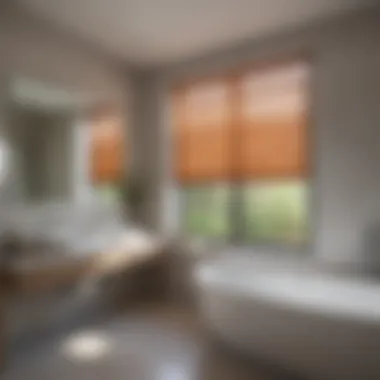
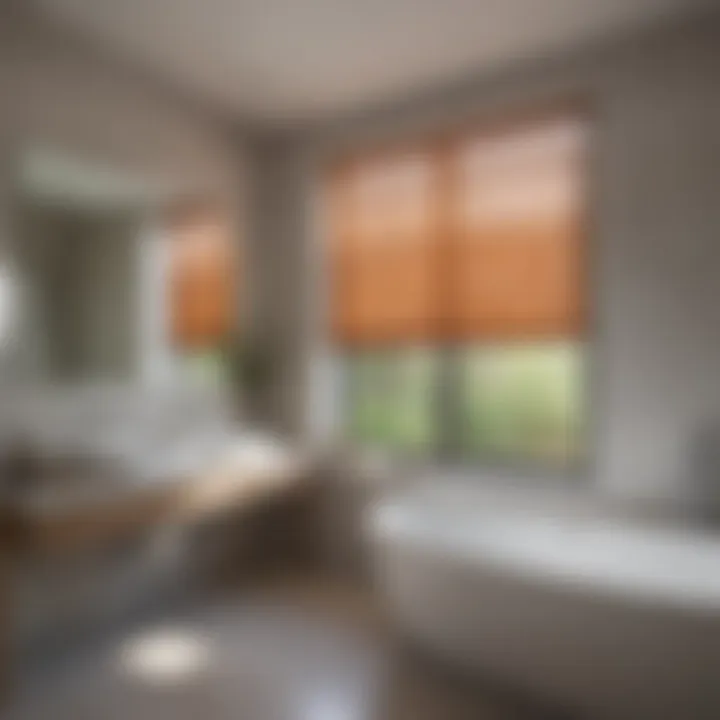
Proper maintenance and care of bathroom windows with blinds inside is essential for ensuring their longevity and performance. Given that bathrooms are often humid environments, these windows require specific attention to both cleanliness and damage prevention. Neglecting maintenance can lead to a range of issues, such as reduced efficiency, compromised aesthetics, and even costly repairs. It is crucial for homeowners to grasp the significance of maintaining these installations in order to protect their investment and enhance the functionality of their space.
Cleaning Techniques for Internal Blinds
Cleaning internal blinds can be straightforward if approached with the right techniques. In most cases, the materials used for blinds are designed to withstand moisture and allow for easy maintenance. To keep the internal blinds functioning well, follow these steps:
- Dust Regularly: Use a soft, microfiber cloth to dust the blinds at least once a month. This prevents dust buildup and maintains their appearance.
- Use a Damp Cloth: For deeper cleaning, slightly dampen a cloth with mild soap and water. Wipe the blinds gently, taking care not to saturate the components.
- Vacuuming: If the design allows, use a vacuum cleaner with a brush attachment to clean between the slats. This effectively removes any dust and debris that may accumulate.
- Avoid Abrasive Cleaners: Refrain from using harsh chemicals or abrasive tools, as these can damage the finish or scratch the surface of the blinds.
Preventing Moisture Damage
Bathroom environments are prone to high levels of moisture, which can lead to various forms of damage if not managed well. Here are ways to help prevent moisture-related issues:
- Ventilation: Ensure that your bathroom is properly ventilated. Using exhaust fans during and after showering can help reduce moisture levels, thus protecting both the windows and the blinds.
- Seal Gaps: Regularly check for gaps around the window frames and seals. Ensuring these areas are properly sealed prevents moisture from seeping into the window structure.
- Regular Inspections: Periodically inspect the blinds and the window frame for any signs of mildew or mold. Early detection means you can act before significant damage occurs.
- Use Dehumidifiers: If your bathroom tends to be very humid, consider using a dehumidifier. This can significantly help to control moisture levels in the room, thus protecting all fixtures.
Keeping your bathroom windows with internal blinds well-maintained is essential for maximizing their benefits and enhancing the overall look of your bathroom. A little care goes a long way in preserving these features.
Taking the time to clean and protect your bathroom windows with internal blinds not only enhances their appearance but also prolongs their lifespan. This is essential in maintaining both the aesthetic and functional aspects of your bathroom. By following these maintenance and care strategies, homeowners can ensure their installations remain in excellent condition for years to come.
Aesthetic Integration in Bathroom Design
Aesthetic integration plays a crucial role in bathroom design, especially when considering windows with internal blinds. These windows offer a balance between functionality and visual appeal, allowing homeowners to enhance their spaces without compromising on practicality. Choosing the right design for bathroom windows demands careful thought about how these elements fit into the overall décor of the room.
Incorporating windows with built-in blinds can transform a bathroom’s aesthetic. They serve not only as a functional piece but also contribute to the style and ambiance of the environment. The right design choices can elevate the entire space, creating a seamless look that invites relaxation and comfort. Here are several key elements and benefits regarding aesthetic integration in bathroom design:
- Functional Beauty: Bathroom windows with internal blinds are a prime example of combining beauty with function. They help in controlling privacy and light while maintaining a sleek, uncluttered look.
- Harmonizing Elements: Selecting the appropriate color schemes and patterns for the blinds can harmonize with fixtures and cabinetry. This cohesion enhances the visual flow in the space.
- Increased Value: A well-integrated bathroom design can increase the property value. Potential buyers appreciate spaces where every element, including the windows, has been thoughtfully considered.
When planning for aesthetic integration, homeowners should consider both personal style and current trends. Understanding how color, patterns, and finishes work together can lead to a more cohesive and attractive bathroom.
Color Schemes and Patterns
The choice of color schemes and patterns in bathroom windows with internal blinds significantly impacts their integration into the overall design. The colors selected should complement existing elements, from tiles to cabinetry, promoting a sense of unity.
Neutral palettes, such as whites, greys, and beiges, can provide a fresh, modern look. Meanwhile, softer pastels add a touch of warmth and personality. Patterns also play a crucial role: subtle textures can add depth, while bold designs can serve as statement pieces.
Consider these factors:
- Consistency with the Room’s Theme: Aligning the color and pattern of the blinds with the bathroom’s overall theme enhances design flow. For instance, coastal-themed bathrooms might benefit from shades of blue or wave patterns.
- Light Reflection: Color can affect how light interacts in the space. Lighter colors reflect more light, making a small bathroom feel larger.
- Mood Setting: Colors can influence the mood of the space. Cooler tones might promote calmness, while warmer tones could create an inviting atmosphere.
Framing and Finishing Options
Framing and finishing options are other important aspects when integrating windows with blinds into bathroom design. The right materials and finishes can significantly enhance the overall aesthetic.
Homeowners can choose from various options including:
- Vinyl Frames: Durable and moisture-resistant, vinyl frames can be painted to match specific color schemes, offering versatility in design.
- Wood Frames: Wooden frames exude warmth and elegance, but they should be treated for moisture resistance to prevent warping.
- Aluminum Frames: For a more contemporary look, aluminum frames provide sleekness and longevity.
In addition to frames, the finishing touches on the blinds themselves can elevate the design:
- Material Selection: Blinds made from materials that resist moisture are paramount. This is particularly important in bathrooms where steam is present.
- Textured Finishes: Textured finishes on the blinds may add interesting visual components without overwhelming the space.
- Trim Details: The trim around the window can also be styled. Profiles can be simple and elegant or elaborate, depending on the desired aesthetic.
Ultimately, the consideration of colors, patterns, framing, and finishing creates a harmonious blend between form and function. By paying attention to these details, homeowners can enjoy a bathroom that is not only practical but also visually pleasing.
Culmination
The conclusion of this article serves as a critical recap of the journey through bathroom windows that feature integrated blinds. This discussion has highlighted various facets of this unique design, making it apparent that these windows provide more than just basic functionality. They blend aesthetics with practicality, enhancing both the appearance of a bathroom and its usability.
Summary of Key Points
- Enhanced Privacy: The internal blinds offer an efficient solution for maintaining privacy without sacrificing natural light. Homeowners can adjust the blinds easily to meet their needs at different times of the day.
- Energy Efficiency: These windows contribute to better energy conservation. Internal blinds can improve insulation, which in turn may lead to lowered energy bills during extreme weather conditions.
- Easy Maintenance: With built-in blinds, cleaning becomes less of a chore. The ability to clean both the glass and the blinds together streamlines upkeep, making it a favorable option.
- Aesthetic Appeal: Available in various materials and styles, these windows can complement any bathroom's design. Homeowners can choose the finish and color of both the blinds and the window frame to create a cohesive look.
- Installation Flexibility: Whether a professional installation or DIY approach, understanding the installation considerations can save time and ensure quality results.
Ultimately, selecting bathroom windows with blinds inside can provide a harmonious balance of design and functionality. This approach paves the way for future trends while also addressing the very real needs of modern homeowners.
Future Trends in Window Design
Looking ahead, the evolution of bathroom windows with integrated blinds is set to continue in innovative ways. Several trends are emerging that will likely shape the future of window design in bathrooms:
- Smart Technology: Integration with home automation systems is on the rise. Homeowners may soon control the blinds remotely via smartphones, further improving convenience and efficiency.
- Sustainable Materials: As environmental concerns take center stage, manufacturers are increasingly focusing on eco-friendly materials for the windows and blinds. Products made from recycled or sustainably sourced materials may become standard.
- Enhanced Insulation Features: Future designs may incorporate advanced insulation techniques that improve overall energy performance, addressing climate control more effectively.
- Customization Options: More brands are likely to offer tailored solutions, allowing homeowners to choose everything from size and shape to the level of light control.
- Innovative Security Features: Expect improvements in security, with internal blinds equipped to deter intruders by blocking sightlines into the home.
These trends will likely influence homeowner choices and preferences, signaling ongoing advancements in the functionality and design of bathroom windows with internal blinds.







